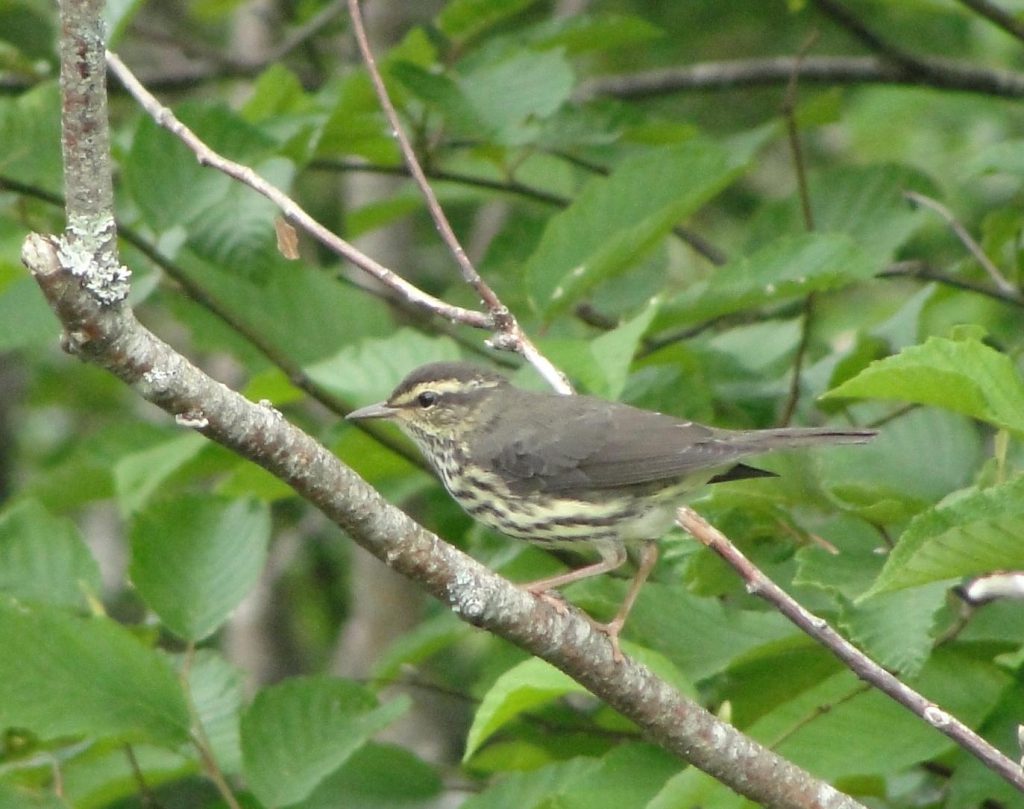Warblers are well into their breeding season. For example, this morning in Eastford, I watched a female Blackburnian warbler gathering cobwebs and small twigs, while a male sang nearby. Nearby, I also saw both black-and-white and yellow warblers carrying food back to their nestlings. Most warblers, however, have fairly specific habitats, and are unlikely candidates for the list of species that could be found in any block. Continue reading
Nesting evidence
Confirming house finches
Back in July 2018 – midway through the project’s first breeding season, I identified 12 species to confirm in every block. Based on results from the first atlas, and my experience atlasing across the state, these 12 species seemed like they could be found pretty much anywhere. Whether that’s true is hard to say without ensuring that we have good coverage in every block. So, the next couple of months are the last chance to follow up and see if these species can be found in places they have not yet been reported from. Continue reading
Early morning at the mall
As 2021 is the last year of data collection for the breeding portion of the atlas project, our focus is very much on filling gaps – looking for species that have been missed and, especially, seeking evidence of confirmed breeding. As a result, whenever I go anywhere beyond my home blocks, I look for ways to fill a few gaps along my route. Continue reading
Fish crows in Connecticut
A recent post on the ctbirds listserv raised the question of whether fish crows nest in Connecticut. The subsequent discussion demonstrated that they do, and that nesting occurs in various parts of the state, but I thought it might be useful to see what the latest atlas data show. Continue reading
In search of pigeons
Earlier this week, I wrote about the value to the atlas of searching for house sparrows. The next day I had to drive to Brooklyn, Connecticut, so I took my own advice and looked for blocks with no house sparrow records between my destination and home. Sure enough, there were three, and with only minor detours to drive by farm buildings in each block I was able to find the species in all of them, confirming it in one where I saw a bird with nest material. I also confirmed breeding for house finch in one block, by seeing a female taking nest material into a bush where it was building a nest. Continue reading
Helpful hints for locating great horned owls nesting sites
The final breeding season for the atlas is underway and although there are only a few species breeding already, great horned owls have been on nests for some time. The maps below, however, show that there are many places where the species was found in the 1980s that have no records from the current atlas: Continue reading
Confirming waterthrushes
As is often the case, discussion on the CTbirds listserv, starting with a post by Preston Lust, led me to take a look at the preliminary atlas species maps this morning. This time, the subject was waterthrushes.
Confirming hummingbirds
Recently I was asked if we’d written a blog post on hummingbirds and had to answer “no”. Ever since, I’ve been thinking about what there is to say on how to confirm breeding for the state’s smallest nesters, as it can be surprisingly difficult (though not as bad as for the closely-related chimney swift). Continue reading
July is the month
When we started the atlas, we told everyone that our goal was to have 20 hours of breeding season survey effort in each block. That time could all be spent by one person who “adopts” the block, or it could be from a mix of people. And, we asked that the time be spread evenly across the breeding season, including visits to all habitats, and with at least a little time listening for nocturnal species. Continue reading
Confirming bobolinks (or, what is a fecal sac?)
A couple of days ago, Chris Loscalzo posted a tip to the CTbirds email list based on his and Marianne Vahey’s observation of nesting bobolinks in Norfolk. Chris pointed out that if you see a bird flying away from a potential nest site with a gleaming white object in its beak, then it is likely to be a fecal sac – and that this confirms breeding (code FS). Continue reading
